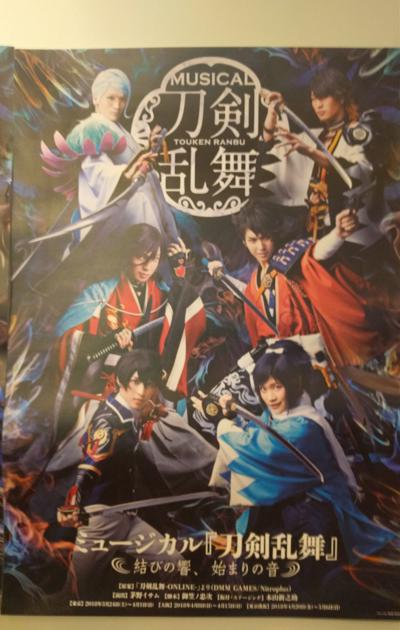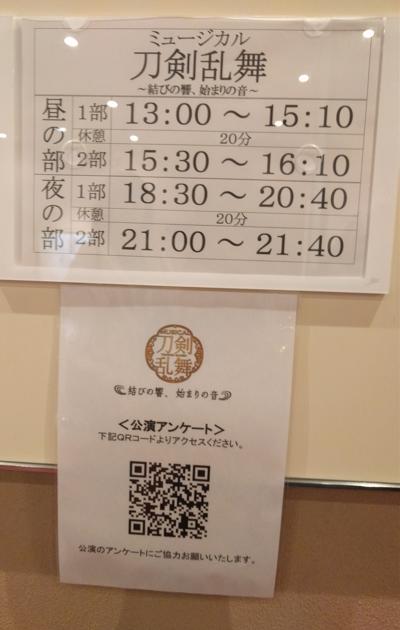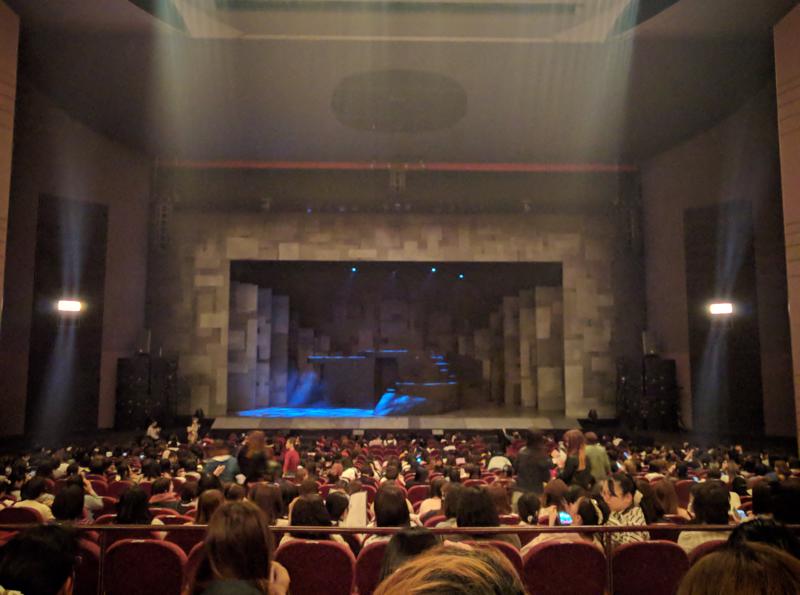Japan, Take 2
So, guess who miraculously got a ticket to see the Touken Ranbu Musical less than 24 hours before curtain.
Remember the lovely anthropomorphic swords I mentioned? Well, now I get to talk a little bit about the 2.5 Dimensional Musical.
Directly from the English version of the website:
The term is used to describe theatrical presentations based on Japanese manga, popular animation and video games.
The meaning implies such theatrical shows exist somewhere between 2D the realm of manga, animation and video games,
and 3D the realm of the theater. The term not only refers to musicals, but also to straight plays, comedies and dramas.
What fascinates me about this genre of entertainment is how they translate (sometimes very elaborate) costume designs from the illustrated medium to
April 10-14 鴻雁北 Geese Fly North
April 11, 2018
|
Osaka
So, guess who miraculously got a ticket to see the Touken Ranbu Musical less than 24 hours before curtain.
Remember the lovely anthropomorphic swords I mentioned? Well, now I get to talk a little bit about the 2.5 Dimensional Musical.
Directly from the English version of the website:
The term is used to describe theatrical presentations based on Japanese manga, popular animation and video games.
The meaning implies such theatrical shows exist somewhere between 2D the realm of manga, animation and video games,
and 3D the realm of the theater. The term not only refers to musicals, but also to straight plays, comedies and dramas.
What fascinates me about this genre of entertainment is how they translate (sometimes very elaborate) costume designs from the illustrated medium to

actual garments for wearing. As someone who actually knows how to construct garments for wear and has also drawn physically impossible fashion illustrations in the past, this 2.5D theatre is a treat.
Now, I have never been one to speak about Cosplay (easy Google search here) because I have watched its emergence into mainstream acceptance from its hidden basement past, and unfortunately, its past still holds a very strong impression on me. The reason why I have never taken part (and still refuse to take part) in this type of costuming is because of the underlying mindset of most cosplayers: the costume is constructed only for temporary use, and as long as its component pieces will stay on the body for the duration of the convention day, the means do not matter.
Most costumes are intended to be worn once, recognized for their Intellectual Property (IP) origins, and then discarded by the end of the day, either because the costume has fallen apart due to poor construction, or, like evening gowns on the red carpet, it would be a disgrace to wear the piece a second time.
This has never settled well with me as a person, both in its disrespectful view on garment construction and its inherent waste, so somewhat ironically, as a professional costumer, I refuse to cosplay.
I mention cosplay off the bat while speaking on 2.5D Musicals because in some ways, this is the definition of Professional Cosplay. True, there have been professional cosplayers in the past number of years who are paid to dress up in their self-constructed costumes, invited as special guests to anime and comic conventions, and have given workshops on their methods. However, they are never expected to do more than stroll through the convention floor, post for photos, and at most, participate in short scripted "plays", which last no more than a few minutes on a bare and/or makeshift stage.
The costumes made for 2.5D entertainment are much closer to my definition of actual costumes in that they are constructed to survive the rigorous use demanded by a theatrical run. Many of the 2.5D Musicals have a very limited run of a week or two, for two shows a day, and you can bet those boys are sweating under all those layers of wigs and makeup. I can only hope their costumes are washed daily. And daily laundry on any type of garment is taxing.
Laundry is the true test of a garment's quality.
Ok, so that is the backdrop of my interest in seeing 2.5D entertainment. Frankly, I know very little about the IP, and can barely understand the Japanese dialogue, so I'm mostly in it to analyze the theatrical production values rather than to take part in fan-girling over the characters/actors.
After discovering 2.5D entertainment at the beginning of this calendar year, I've been keeping an eye out on the website in hopes to attend a performance or two. The Touken Ranbu production was one that was most easily accessible to me geographically. However, tickets were sold out way before I realized how the ticketing system worked.
(aside on tickets. Due to their insane popularity and retardedly limited runs, many of these productions offer "lottery style" tickets, wherein you apply through a lottery system to hope to get tickets. These appear to be the first run of ticket sales, before they open up general ticket sales, and then, in this particular case, last minute openings the week before show.)
This show piqued my interest since the costumes are more historical/fantastical than, oh, high school basketball (yes, there is a Kuroko no Basket 2.5D musical. I'm sorry, there's only so much skill required in making a basketball jersey and it's not enough of a draw for me), and I was pretty much resigned to not being able to see the show during its week-long Osaka run. I don't know why I kept checking the ticketing website, but I noticed that they had opened up some last minute seats for the week. Luckily, there were open seats for the Wednesday morning show (I was checking the website Tuesday evening) and I had no scheduled classes. After a bit of a freakout few minutes of wondering why my credit card was not working on the website and realizing they probably didn't authorize overseas credit cards with less than 24 hours notice, I hoofed it to the nearest Lawson to try and get the last minute ticket. Thankfully, it was not sold out in the 10 minute walk. Turns out I had purchased a ticket voucher, and would get my seat assignment on a first-come, first-serve basis the morning of the show. Good thing I arrived early enough to figure that out.
The theatre opened at 12:15, and when I arrived around 11:30 the line waiting to enter had already snaked into at least 4 lines. And yes, the line was roughly 95% female. Not all young females either. There were definitely some ladies there in their 50s. I mean, if I can tell they're in their 50s, they do not look young.
I made the executive decision to purchase goods since a) I was early and had absolutely nothing better to do and b) I have successfully argued with myself that this is research material that I can not purchase anywhere else. That said, I

purchased the show pamphlet and the photo sets of the main characters.
Research material. Is. Not. Cheap.
My seat was centre house, about 4 rows in front of the sound board, so I got a really good view... of the person sitting in front of me whose head was directly in my sightline to the stage. Short person problems. Also, the seats were not offset, so she was literally in front of my face. It was an annoyance I got over.
As I was completely unfamiliar with the IP, and understood maybe 30% of the Japanese dialogue, I focused most of my attention to the production values instead. There were certain parts where I silently wondered if everyone around me had allergies, but I realized I was probably missing out on some very emotional material.

What really impressed me about this production was the central set piece. As most Japanese theatres do, this one also had a rotating stage, and they had a pyramid/mound at the main set piece. Since the set rotated, the set piece was built to be useful in all 360º. It was nothing but stairs and slopes with a central opening, which created so many useful levels for fight choreography. It was stunning to see it in action. I had a good laugh whenever they did a blackout for scene changes, since they had to demarcate all the corners and slopes on the set with glow-in-the-dark tape, and that thing lit up like a Christmas tree it was so full of trip hazards.
The FIGHT CHOREOGRAPHY.
As typical of traditional Japanese stage fight choreo, it was all basically tachimawari, where none of the weapons actually made contact. Contact sound effects were played instead, which of course could be played much louder to produce the type of tension you want, and since the blade foils reflected the stage lights so well, it still looked like it could be believable danger. What was impressive was the sheer number of people they had on stage at one time with swords. There were several scenes where between 18-20 people, each with a sword, were fighting simultaneously on stage. It was not a particularly large stage, definitely more standard-sized than the wider Kabuki stage, but they had 6 protagonists and each one of them would fight at least 2 chorus members in each stage fight. They made dang good use of all those levels on that central set mound. I am honestly considering purchasing the DVD just to rewatch all those fights.
Fun aside: Very first scene of the play, one of the 6 main characters (the super long-haired on who looks freakishly girly) had to exit through the rotating set and totally walked into the set. We all heard it.
Interestingly enough, the main story part was over by intermission. What followed intermission was more like a concert than anything else. The audience fans brought out their branded glow/light "penlight" sticks, their literal fans (the girl beside me had brought her decorated uchiwa fan in a nice plastic case to protect it for this portion of the performance), and anything else they wanted to wave to participate/hope to gain attention of the performers. I was not expecting the main cast to walk out into the audience to "greet" the fans during the last song, but that allowed me to see just how young they were, and just how much makeup they had on. And really "young" in this case just means they're in their 20s.
Sadly, they were no longer in the same costumes from the first portion, which had the more interesting pieces. Lots of screaming from the audience. They spread themselves out fairly well, as the main 6 were not confined to the main floor, but also went up to the mezzanine as well. Don't know if they made it to the balcony. Since my last minute ticket was for the "good seats", I got to see them pretty up close and personal. Now I might just have to keep buying tickets for the good seats for shows here on out. Curses.
Not going to lie, the secondary cast (who were older as well) had a much more enjoyable song.
And that is as much of a summary as I want to make on this for now. I am excited to try and see more of this genre of entertainment.
1.
Foreword
2.
72 Seasons of Japan: 雪下出麦 Beneath the Snow the Wheat Sprouts (January 1-5)
3.
Pheasants are like peacocks, right? 雉始雊 The Pheasant's First Calls (January 16-20)
4.
January 21-24 款冬華 The Butterbur flowers
5.
January 25-29 水沢腹堅 Mountain Streams Freeze
6.
January 30-February 3 鶏始乳 The Hens start laying eggs
7.
February 4-8 東風解凍 Spring winds thaw the ice
8.
February 9-13 黄鶯睍睆 The Nightingale Sings
9.
February 14-18 魚上氷 Fish Rise from the Ice
10.
February 19-23 土脉潤起 The Earth becomes Damp
11.
February 24-28 霞始靆 Haze First Covers the Sky
12.
March 1–5 草木萌動 Plants Show First Buds
13.
March 6–10 蟄虫啓戸 Hibernating Creatures Open their Doors
14.
March 11–15 桃始笑 The First Peach Blossoms
15.
March 16–20 菜虫化蝶 Leaf Insects become Butterflies
16.
March 21-25 雀始巣 The Sparrow Builds her Nest
17.
March 26-30 櫻始開 The First Cherry Blossoms
18.
March 31-April 4 雷乃発声 Thunder Raises its Voice
19.
April 5-9 玄鳥至 The Swallows Arrive
20.
April 10-14 鴻雁北 Geese Fly North
21.
April 15-19 虹始見 The First Rainbow Appears
22.
April 20-24 葭始生 The First Reeds Grow
23.
April 25-29 霜止出苗 The Frost Stops; The Rice Grows
24.
April 30- May 4 牡丹華 The Tree Peony Flowers
25.
May 5-9 蛙始鳴 The First Frogs Call
26.
May 10-14 蚯蚓出 The Earth Worms Rise
27.
May 15-20 竹笋生 Bamboo Shoots Appear
28.
May 21-25 蚕起食桑 The Silk Worm Awakes and Eats the Mulberry
29.
May 26-30 紅花栄 The Safflower Blossoms
30.
May 31-June 5 麦秋至 The Time for Wheat
31.
June 5 - June 9 蟷螂生 The Praying Mantis Hatches
32.
June 10 - 15 腐草為螢 Fireflies rise from the Rotten Grass
33.
June 16 - 20 梅子黄 The Plums turn Yellow
34.
June 21 - June 25 乃東枯 The common Self-Heal Dries (Summer Solstice)
35.
June 26 - June 30 菖蒲華 The Iris Flowers
36.
July 1 - July 6 半夏生 The Crow-dipper Sprouts
37.
July 7 - July 11 温風至 Hot Winds Blow
38.
July 12 - July 16 蓮始開 The First Lotus Blossoms
39.
July 17 - July 21 鷹乃学習 The Young Hawk Learns to Fly
40.
July 22 - July 27 桐始結花 The First Paulownia Fruit Ripen
41.
July 28 - Aug 1 土潤溽暑 Damp Earth Humid Heat (Major Heat)
42.
Aug 2 - Aug 6 大雨時行 Heavy Rain Showers
43.
Aug 7 - Aug 11 涼風至 A cool Wind blows (First Autumn)
44.
Aug 12 - Aug 16 寒蝉鳴 The Evening Cicada Sings
45.
Aug 17 - Aug 22 蒙霧升降 Thick Fog Blankets the Sky
46.
Aug 23 - Aug 27 綿柎開 The Cotton Lint Opens (Limit of Heat)
47.
Aug 28 - Sept 1 天地始粛 Earth & Sky Begin to Cool
48.
Sept 2 - Sept 6 禾乃登 The Rice Ripens
49.
Sept 7 - Sept 11 草露白 Dew Glistens White on Grass
50.
Sept 12 - Sept 16 鶺鴒鳴 Wagtails Sing
51.
Sept 17 - Sept 21 玄鳥去 Swallows Leave
52.
Sept 22 - Sept 27 雷乃収声 Thunder Ceases (Autumn Equinox)
53.
Sept 28 - Oct 2 蟄虫坏戸 Insects hole up Underground
54.
Oct 3 - Oct 7 水始涸 Farmers Drain Fields
55.
Oct 8 - Oct 12 鴻雁来 The Geese Arrive
56.
November 19
Share your travel adventures like this!
Create your own travel blog in one step
Share with friends and family to follow your journey
Easy set up, no technical knowledge needed and unlimited storage!